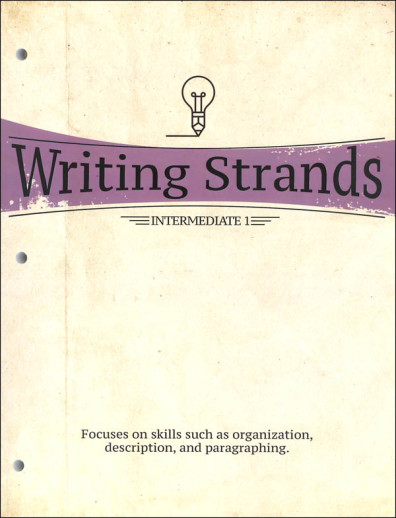We use cookies to make your experience better. To comply with the new e-Privacy directive, we need to ask for your consent to set the cookies. Learn more.
Writing Strands: Intermediate 1
Designed for students who have completed Writing Strands Beginning 2 or are in grades 4 - 9, depending on skill level. Focuses on skills such as organization, description, and paragraphing. Students will understand that ideas in sentences are connected, and flow from one sentence to the next; list the main points in the summary of a story; understand that there is a voice which speaks to the reader; realize the structure of description, and start descriptions_1 with general statements; use past tense, present tense, and future tense; and recognize a character's physical positions and realize how position controls what characters know. Literature lessons include plot (sequence of events, cause/effect, character, driving forces, exposition, complication, rising action, climax, falling action, resolution, putting it all together, and conflict among individuals, society, setting, and internally. 279 pgs. pb.
Students completing this course will learn to express their feelings in writing, organize their thoughts into cohesive sentences, develop outlines, organize specific writing prompts, and more.
Topics addressed in this one-year course include:
- Recognizing and listing the main parts of story structure
- Organizing information in paragraphs and writing topic sentences
- Turning an image into a verbal description
- Learning the appropriate use of tense
- Learning how the attitudes of narrative voices affect a reader's reactions
- Controlling sentence length to help readers understand material.
A suggested daily schedule is provided, as well as worksheets that are three-hole punched and perforated, and the addition of a reading and literature component that helps students look more deeply into the Bible and other books they select.
Writing Strands, long a homeschooling favorite, has received an expansion and facelift from its new publisher, Master Books. Still providing the same quality, step-by-step writing instruction, the major difference is that there is MORE than just writing instruction. A complete series of reading/literature lessons is interwoven with the writing instruction resulting in solid language arts courses. Each consumable worktext provides space to complete the writing assignments as well as worksheets for discussing books (chosen and assigned by teacher/parent) and Bible passages. The student is encouraged to keep an ongoing spelling list as well as constantly be involved in the writing evaluation process. Composition lessons cover the writing process and provide experience with the various forms of writing as well as specific traits of good writing. Reading/literature lessons provide literary analysis instruction coupled with discussion questions and biblical applications.
All instruction is provided in the Student Worktexts. Students are encouraged to build a portfolio binder although there is ample space provided to complete many of the Worktext assignments. Introductory information includes course descriptions/principles, writing guidelines, skills writing mastery chart, list of problems to solve (this is kept as a running list based on assignment completion), and a detailed daily schedule. Detailed lessons, written directly to the student, are provided for 180 days (five days a week; four 9-week quarters) and can be expected to take 30-45 minutes to complete. Bible passages are used as the primary resource for the literary analysis lessons. These lessons are coupled with book studies using literature selections chosen by the parent. Answer keys for objective portions are included as well as a glossary of helpful terms.
This edition is a bit more grade specific than the previous version although there is still some flexibility. Each level is a one-year course. Typically students would begin the series in 5th grade and progress through 10th but a student with good reading skills could start in 4th (possibly, 3rd). An older student (ex. 7th grade) would typically start with Intermediate 1 but could start with a lower level if their writing skills are minimal. Students should be able to enter at grade level assuming they are reading at or above grade level. Grammar and spelling are covered from a usage perspective so you may want to add a grammar and/or spelling workbook for practice and basic instruction. All course books are three-hole punched. ~ Janice


We had used an older version years ago with the oldest child and I'm happy to see they've been revised with more content.
This series has a simple, progressive way to develop writing skills.
Looks simple to use and also covers the areas I desired to teach. Also, can you be used for multiple grade levels.
It's biblical and practical.